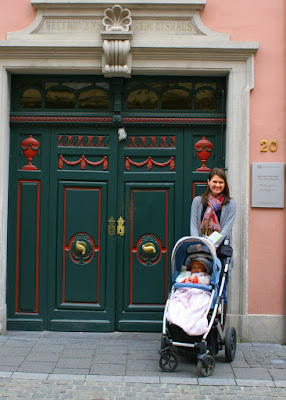I am a flower fanatic. The best way to make my day is to give me a bunch of brightly colored flowers. (Every once in a while the Father remembers this, but most of the time I resort to buying flowers for myself and pretend they're from him.) I especially love the bulbs that come up in the Spring--crocuses, hyacinths, daffodils, tulips...I could go on and on. In fact, I'll confess that the main reason I wanted us to buy a house when we moved to North Carolina was so that I could have a garden. And within a few weeks of moving in I already had bulb catalogues in my hand and was ready to place some orders. So you can bet that soon after our move to Germany last summer, going to see the tulips in Holland became a goal of mine. Last week we headed to Holland during the middle of their tulip season...And boy did we see some tulips!
We traveled to Lisse, Holland to see the Keukenhof Gardens. There really is no better place on Earth to go to see flowers. It is the largest garden in the world!
The fields of flowers stretched as far as the eye could see. When we were there the hyacinths were at their peak. Their sweet smell was thick in the air.
The sad thing about these flowers is that they are only being grown for their bulbs. Soon the flowers will be cut down, and the bulbs will be harvested and sold.
The Keukenhof gardens are only open a few months every Spring. They spend the rest of the year replanting and cultivating the bulbs for the next year.
These tulips are my favorite. They look like big, fluffy roses instead of tulips.
We spent over two hours wandering around the gardens, but that wasn't even enough time to see all of it.
Of course, that might have also been because we kept stopping to take pictures.
We tried to teach Penelope how to smell the flowers.
Even when we told her not to.
See that guilty face...
There were signs posted everywhere about not picking flowers or walking on the grass. We were worried that we were going to get stopped by the Flower Police.
But Penelope's interests quickly moved from touching flowers and running through grass to digging in the dirt.
So much so that she completely ignored all the flowers and went directly for the dirt below.
Besides flowers, there was also an old windmill you could climb up. (Windmills and tulips naturally belong together, don't they?)
There were lots of beautiful fountains and ponds too.
Like most of Holland, there were also canals running through the flower fields that you could take a boat ride down.
This year the gardens featured a huge flower mosiac.
Basically, we all had an amazing time at Keukenhof. Here are a few more snapshots to prove it...

























